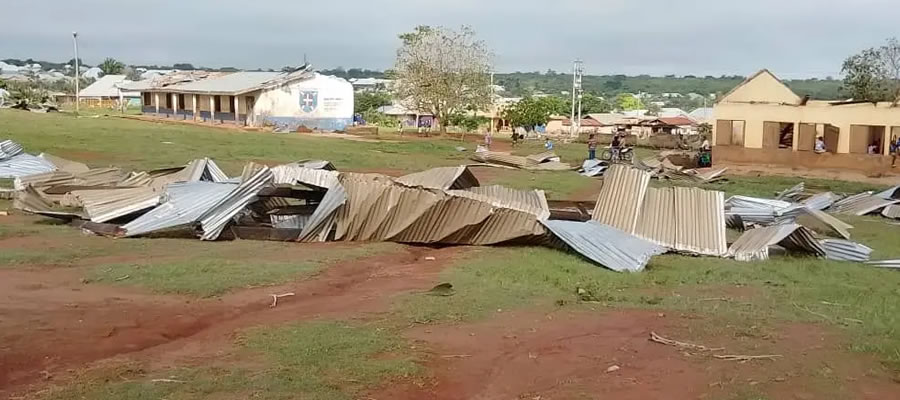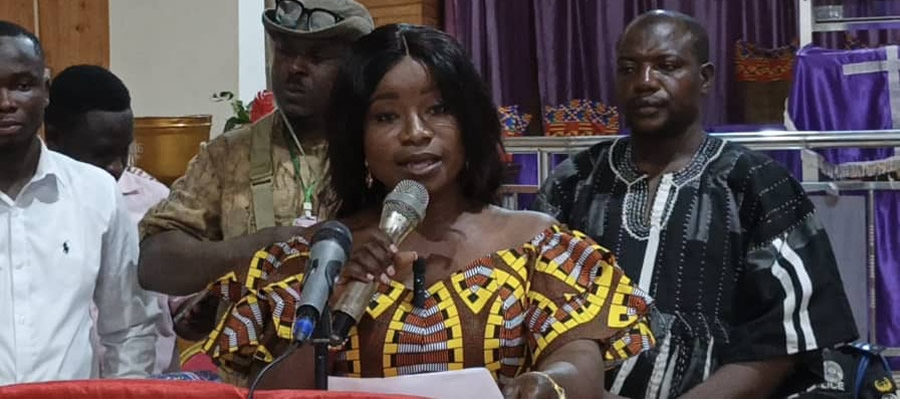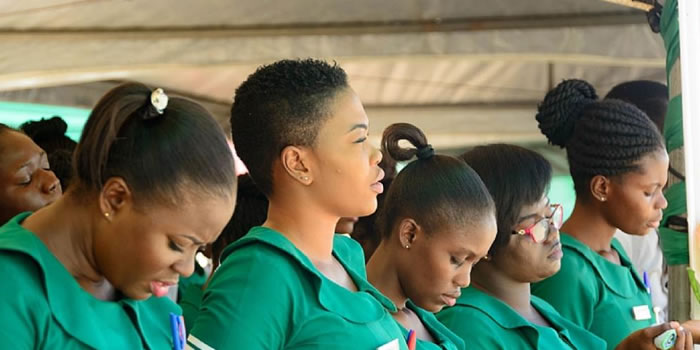

Support Services
i) Road and Transportation
One of the key factors for the development of the rural areas is a good road network. It determines the pattern of movement and ensures the pattern of distribution of goods and services in a particular area. The road network in the district is such that every settlement can be reached by some form of road of varying quality.
The major highway passing through the District is the Kumasi-Wa road. This road appears to be the best tarred road in the district. Settlements along this main road have no problem with transportation as lorries frequently use the road. The other highway is the Wenchi-Nsawkaw road, which leads to Cote d’Ivoire. This road is also tarred.
There are many feeder roads connecting the two major roads in the district. The remaining highway is Wenchi-Sunyani.
The feeder roads are generally poor and unmotorable during the rainy season. The risks posed by transportation are related to poor road conditions. Travelling on these roads during the rainy season is very difficult, risky and disrupts agricultural marketing and other economically important communications. During the rainy season, tractors are often used on bad roads.
The implication of the nature of the road is obvious: frequent breakdown of vehicles, high transport cost, patients not being able to reach the health centres in emergency situations early, and much of the perishable produce either perish or are sold at cheaper prices at farm gates. Investors interested in commercial farming may not be easily attracted.
The role of the private sector in road transportation in the district is very significant. The private sector captures over 98% of all the road transport business. Private transportation is well organized by the Ghana Road Transport Union GPRTU) at Wenchi and Subinso.
The road network is appreciable but most of the roads need upgrading to open up the entire district for total development.
Other Support Services
Other good infrastructure apart from roads are schools, clinics, pipe borne water, tele-communication and financial institutions and good market facilities.
Easy acquisition of land
Availability of Business Advisory Center (BAC) to counsel would-be Business Enterprises
Availability of Electricity connected to national Grid to most parts of the District for domestic and commercial purpose.
Availability of Donor funded projects which investors can take advantage of including Community Based Rural Development Project etc.
Security to protect visitors, investors and tourists as well as the general public.
There are a number of hotels with good accommodation facilities for visitors and tourists. Some of the hotels include Viglosam, Pony and Baah. These hotels have security men protecting visitors. They have standard facilities in both single and self contained rooms. The hotels also have conference halls, various Ghanaian dishes and drinks of various kinds (Minerals, Beer, Guinness, etc)
The District Assembly needs to take advantage of the potentials by developing the existing tourists’ attraction in the Districts.
Accessibility to Market Centres
The district adopted 40 minutes as the maximum time it must take in reaching a market centre. This means that for an individual to travel to any market centre, it must not take more than 40 minutes. If it takes more than 40 minutes, then the person or community is said to be out of reach of the centre.
Travelling along a first class road, any community within 42.7km distance from the location of a market is said to be accessible. Similarly, all settlements within 13.3km from a market centre, travelling along a feeder road, can also conveniently reach it. However, if the means of transport is merely by walking, then the distance must not exceed 2.7km.
There are 7 identifiable market centres in the district. A look at Figure 11 shows that six (6) of these are located along the major road, with the last one at Nchiraa. Besides Wenchi, other communities like Awisa, Nchiraa, Tromeso, Buoku, Subinso No 2, Hiamankyire and Buoku also have market centres.
Accessibility to Service
Analyses of accessibility to selected services were done to determine areas within the district that have easy access to these services. Invariably, areas of limited access were also carved out. The analysis was done to determine only the physical accessibility to these facilities.
Factors taken into consideration included;
The surface condition of roads in the District
Acceptable travel times to the selected services
Speed limits on the roads
waiting time (before one gets a means of transport)
Based on the determined speed limit and waiting times on the various roads in the district, an analysis was done and the area of coverage of the selected facilities/services are shown in columns 3 to 5.
Accessibility to Health Facilities
The acceptable travel time adopted in reaching a health facility is 30 minutes. This means that for an individual to access a health facility, it must not take more than 30 minutes. If it takes more than 30 minutes to reach a health facility, then the person or community is said to be out of reach of the service.
Going by a second class road, any community within 32km distance from the location of a health facility is therefore said to be accessible to the facility. In a like manner, all settlements within 10km from a health facility, travelling along a feeder road can also conveniently reach a health facility. However, if the means of transport is merely by walking, then the distance must not be over 2km.
In calculating accessibility to health services, Hospitals and Health centres were chosen. As can be seen from Figure 7 below, all the communities along the major road, running from Buoku in the South, through Wenchi, to Branam in the North have access to a health facility. Other settlements like Nchiraa, Wurompo and Nwoase are also accessible by means of feeder roads.
Accessibility to Educational Facilities
The acceptable travel time adopted in reaching an educational facility (Senior Secondary School) is 45 minutes. This means that for an individual to travel to any Senior Secondary School, it must not take more than 45 minutes. If it takes more than 45 minutes to reach a Senior Secondary School, then the person or community is said to be out of reach of the service.
Going by the second class road in the district, any community within 48km distance from the location of the school is said to be accessible. Similarly, all settlements within 15km from a Senior Secondary School, travelling along a feeder road, can also conveniently reach it. However, if the means of transport is merely by walking, then the distance must not be over 3km.
Typical of most districts in Ghana, almost all the Senior Secondary Schools are located in Wenchi, the district capital. There is only one school located outside the district capital and this is at Koase, which is just about 4km from the district capital. Using these two settlements as the service centres, all the communities along the major road, running from Buoku in the South, through Wenchi, to Branam in the North have access to a Senior Secondary School.
Communities in the extreme South Western and Northern Eastern parts of the district are however not accessible because of the distance between them and the service centres. For this reasons villages like Nchiraa and Asuofri are not within reach.
Accessibility to Banking Services
This means that for an individual to travel to any Banking Facility, it must not take more than 40 minutes. Beyond 40 minutes any community will be out of reach of the service.
Going by a first class road, any community within 42.7km distance from the location of the Bank is said to be accessible. Similarly, all settlements within 15km from a Bank, traveling along a feeder road, can also conveniently reach it. However, if the means of transport is merely by walking, then the distance must not be over 2.7km.
Through out the district, only Wenchi and Subinso No. 2 have Banking facilities. Since these two settlements are along the major road, running from Buoku in the South, through Wenchi, to Branam in the North, all settlements along the road have access to the facility.
Most communities to the west of the major road however do not have access to the facility. This is due to the fact that most of the communities in that area not linked by any road. For this reasons, villages like Mframaso, Boasu and Hiamankyire among others, are not within reach. This has serious implications for the economic growth of these communities since these communities may not be able to save.
Accessibility to Agricultural Extension Services
The acceptable travel time adopted in accessing agric extension services is 20minutes. This means that for an individual to access an agric extension service, he must not spend more than 20 minutes. If it takes more than 20 minutes to access extension service (being the extension officer reaching the farmer or vice versa), then the community is said to be out of reach of the service.
Using a first class road, any community within 21.3km distance from the station of an agric extension officer is said to be accessible. In a like manner, any settlement within 6.7km distance, travelling along a feeder road, can also conveniently reach him. However, if the means of transport is merely by walking, then the distance must not be over 1.3km.
Wenchi district has sixteen (16) agric extension stations serving the various operational areas which are spread through out the district. A look at Fig 10 shows that almost all the communities in the district have access to extension services, except those settlements in the western portions of the district that are not linked by any form of road. These settlements are also far from the stations (more than 1.7km.) Fig 10 below gives a picture of accessibility to agric extension services in the district.
Accessibility to Market Centres
The district adopted 40 minutes as the maximum time it must take in reaching a market centre. This means that for an individual to travel to any market centre, it must not take more than 40 minutes. If it takes more than 40 minutes, then the person or community is said to be out of reach of the centre.
Travelling along a first class road, any community within 42.7km distance from the location of a market is said to be accessible. Similarly, all settlements within 13.3km from a market centre, travelling along a feeder road, can also conveniently reach it. However, if the means of transport is merely by walking, then the distance must not exceed 2.7km.
There are 7 identifiable market centres in the district. A look at Figure 11 shows that six (6) of these are located along the major road, with the last one at Nchiraa. Besides Wenchi, other communities like Awisa, Nchiraa, Tromeso, Buoku, Subinso No 2, Hiamankyire and Buoku also have market centres.
Aggregate and Optimum Accessibility to Services and Facilities
Aggregate Accessibility measures the level of accessibility to at least one the selected services/facilities (being it health, education-S.S.S, Market, Agric extension or banking service in the case of Wenchi District). Aggregate accessibility in the district is over 95% as depicted in Figure 12. This means mostly those in the hinterlands do not even have access to agric extension service, which has most coverage. This call for serious consideration, since the main activity in the district is farming.
Optimum Accessibility on the other hand refers to the level of accessibility to all of the individual facilities under consideration. In the Wenchi District, a look at Figure 13 shows that unlike the aggregate accessibility, which covered both settlements along the major and minor roads, the optimum accessibility coverage is close to 99% along the major roads.
The physical accessibility analysis gives a clear picture of the problems and challenges outlined by the people in the district. It lays more emphasis on the kind of interventions the district needs to reduce poverty and create wealth.
Date Created : 11/21/2017 5:44:36 AM













 facebook
facebook
 twitter
twitter
 Youtube
Youtube
 +233 593 831 280
+233 593 831 280 0800 430 430
0800 430 430 GPS: GE-231-4383
GPS: GE-231-4383 info@ghanadistricts.com
info@ghanadistricts.com Box GP1044, Accra, Ghana
Box GP1044, Accra, Ghana